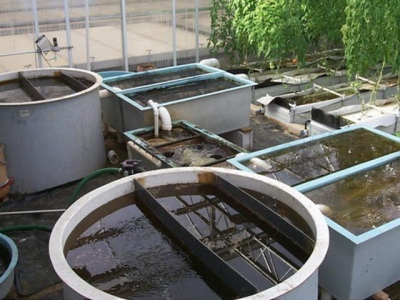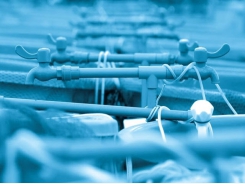A Guide to Recirculation Aquaculture - Part 4

Degassing, aeration, and stripping
Before the water runs back to the fish tanks accumulated gases, which are detrimental to the fish, must be removed. This degassing process is carried out by aeration of the water, and the method is often referred to as stripping. The water contains carbon dioxide (CO2 ) from the fish respiration and from the bacteria in the biofilter in the highest concentrations, but free nitrogen (N2 ) is also present. Accumulation of carbon dioxide and nitrogen gas levels will have detrimental effects on fish welfare and growth. Under anaerobic conditions hydrogen sulphide (H2 S) can be produced, especially in saltwater systems. This gas is extremely toxic to fish, even in low concentrations, and fish will be killed if the hydrogen sulphide is generated in the system.
Aeration can be accomplished by pumping air into the water whereby the turbulent contact between the air bubbles and the water drives out the gases. This underwater aeration makes it possible to move the water at the same time, for example if an aeration well system is used (see figure 2.12).

Figure 2.12 Aeration well system.

Figure 2.13 Photo and drawing of trickling filter wrapped in a blue plastic liner to eliminate splashing on the floor (Billund Akvakulturservice, Denmark). The aeration/stripping process is also called CO2 -stripping. The media in the trickling filter typically consists of the same type of media as used in fixed bed biofilters – see figure 2.10.
The aeration well system is however not as efficient for removing gases as the trickling filter system, also called a degasser. In the trickling system, gases are stripped off by physical contact between the water and plastic media stacked in a column. Water is led to the top of the filter over a distribution plate with holes, and flushed down through the plastic media to maximise turbulence and contact, the so called stripping process.
Oxygenation
The aeration process of the water, which is the same physical process as degassing or stripping, will add some oxygen to the water through simple exchange between the gases in the water and the gases in the air depending on the saturation level of the oxygen in the water. The equilibrium of oxygen in water is 100% saturation. When the water has been through the fish tanks, the oxygen content has been lowered, typically down to 70%, and the content is reduced further in the biofilter. Aeration of this water will typically bring the saturation up to around 90%, in some systems 100% can be reached. Oxygen saturation higher than 100% in the inlet water to the fish tanks is however oft en preferred in order to have sufficient oxygen available for a high and stable fish growth. Saturation levels above 100% call for a system using pure oxygen.

Figure 2.14 Oxygen cone for dissolving pure oxygen at high pressure and a sensor (probe) for measuring the oxygen saturation of the water. Source: AKVA group/ Oxyguard International.
Pure oxygen is oft en delivered in tanks in the form of liquid oxygen, but can also be produced on the farm in an oxygen generator. There are several ways of making super-saturated water with oxygen contents reaching 200-300 %. Typically high pressure oxygen cone systems or low head oxygen systems, such as oxygen platforms are used. The principle is the same. Water and pure oxygen are mixed under pressure whereby the oxygen is forced into the water. In the oxygen cone the pressure is accomplished with a pump creating a high pressure of typically around 1.4 bar in the cone. Pumping water under pressure into the oxygen cone consumes a lot of electricity. In the oxygen platform the pressure is much lower, typically down to about 0.1 bar, and water is simply pumped through the box mixing water and oxygen. The difference in the two kinds of systems is that the oxygen cone solution uses only a part of the circulating water for oxygen enrichment, whereas the oxygen platform is used for the main recirculation flow oft en in combination with the overall pumping of water round in the system.

Figure 2.15 Oxygen platf orm for dissolving pure oxygen at low pressure while pumping water around in the farm. The system typically increases the level dissolved oxygen to just above 100% when entering the fish tanks depending on fl ow rates and farm design. Source: FREA Aquaculture Solutions
Whatever method is used, the process should be controlled with the help of oxygen measurement. The best way of doing so is to have the oxygen probe measuring aft er the oxygenation system at normal atmospheric pressure, for example in a measurement chamber delivered by the supplier. This makes the measurement easier than if it was made under pressure, since the probe will need to be wiped clean and calibrated, from time to time.
Ultraviolet light
UV disinfection works by applying light in wavelengths that destroy DNA in biological organisms. In aquaculture pathogenic bacteria and one-celled organisms are targeted. The treatment has been used for medical purposes for decades and does not impact the fish as UV treatment of the water is applied outside the fish production area. It is important to understand that bacteria grow so rapidly in organic matter that controlling bacterial numbers in traditional fish farms has limited effect. The best control is achieved when effective mechanical filtration is combined with a thorough biofiltration to effectively remove organic matter from the process water, thus making the UV radiation work efficiently.
The UV dose can be expressed in several different units. One of the most widely used is micro Watt -seconds per cm2 (µWs/cm2 ). The efficiency depends on the size and species of the target organisms and the turbidity of the water. In order to control bacteria and viruses the water needs to be treated with roughly 2 000 to 10 000 µWs/cm2 to kill 90% of the organisms, fungi will need 10 000 to 100 000 and small parasites 50 000 to 200 000 µWs/cm2 .

Figure 2.16 Closed and open UV treatment systems: For installation in a closed piping system and in an open channel system respectively. Source: ULTRAAQUA.
UV lighting used in aquaculture must work under water to give maximum efficiency, lamps fitted outside the water will have little or no effect because of water surface reflection.
Ozone
The use of ozone (O3 ) in fish farming has been criticised because the effect of over-dosing can cause severe injury to the fish. In farms inside buildings, ozone can also be harmful to the people working in the area as they may inhale too much ozone. Thus correct dosing and monitoring of the loading together with proper ventilation is crucial to reach a positive and safe result.
Ozone treatment is an efficient way of destroying unwanted organisms by the heavy oxidation of organic matter and biological organisms. In ozone treatment technology micro particles are broken down into molecular structures that will bind together again and form larger particles. By this form of flocculation, microscopic suspended solids too small to be caught can now be removed from the system instead of passing through the different types of filters in the recirculation system. This technology is also referred to as water polishing as it makes the water clearer and free of any suspended solids and possible bacteria adhering to these. This is especially suitable in hatchery and fry systems growing small fish, which are sensitive to micro particles and bacteria in the water.
Ozone treatment can also be used when the intake water to a recirculation system needs to be disinfected.
It is worth mentioning that in many cases UV treatment is a good and safe alternative to ozone.
pH regulation
The nitrifying process in the biofilter produces acid, thus the pH level will drop. In order to keep a stable pH a base must be added to the water. In some systems a lime mixing station is installed dripping limewater into the system and thereby stabilizing pH. An automatic dosage system regulated by a pH-meter with a feedback impulse to a dosage pump is another option. With this system it is preferable to use sodium hydroxide (NaOH) as it is easy to handle and making the system easier to maintain. Sodium hydroxide is a strong alkaline that can severely burn eyes and skin. Safety precautions must be taken, and glasses and gloves must be worn while handling this and other strong acids and bases.

Figure 2.17 Dosage pump for pH regulation by preset dosing of NaOH. The pump can be connected to a pH sensor for fully automatic regulation of pH level.
Có thể bạn quan tâm
Phần mềm

Phối trộn thức ăn chăn nuôi

Pha dung dịch thủy canh

Định mức cho tôm ăn

Phối trộn phân bón NPK

Xác định tỷ lệ tôm sống

Chuyển đổi đơn vị phân bón

Xác định công suất sục khí

Chuyển đổi đơn vị tôm

Tính diện tích nhà kính

Tính thể tích ao hồ



 A Guide to Recirculation Aquaculture - Part 5
A Guide to Recirculation Aquaculture - Part 5  A Guide to Recirculation Aquaculture - Part 3
A Guide to Recirculation Aquaculture - Part 3